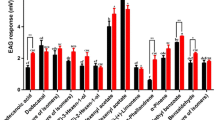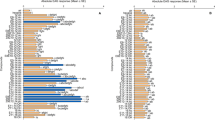Abstract
Cnaphalocrocis medinalis Guenée (Lepidoptera: Pyralidae) is a notorious pest of rice, Oryza sativa L. (Poaceae). Sex pheromones and host-plant volatiles can trap C. medinalis separately. To improve the trap efficiency of synthetic sex pheromone blend, we first tested the synergistic effect of 8 host-plant volatiles, including 2-phenylethanol, 1-hexanol, 1-heptanol, (Z)-3-hexenal, (E)-2-hexenal, octanal, valeraldehyde, and methyl salicylate, on the attraction of C. medinalis to the female-produced sex pheromones in electroantennography. The addition of (E)-2-hexenal, methyl salicylate, valeraldehyde, and (Z)-3-hexenal increased electroantennogram response of C. medinalis to sex pheromones. Further behavioral testing in wind tunnel experiments indicated that additive (E)-2-hexenal or methyl salicylate stimulated the landing behaviors of both male and female C. medinalis compared with sex pheromones alone. Field evaluations showed that mixtures of sex pheromones and (E)-2-hexenal /methyl salicylate resulted in significantly higher catches to male moths than sex pheromones alone. Using 1:1 and 1:10 combinations of the sex pheromones and (E)-2-hexenal, the attraction of C. medinalis to mixtures showed a synergistic effect of 95% and 110%, respectively. Furthermore, 1:1 and 1:10 mixtures of the sex pheromones and methyl salicylate exhibited a synergistic effect of 69% and 146%, respectively. These results may provide the basis for developing efficient pest management strategies against C. medinalis using host-plant volatiles and insect sex pheromones.


Similar content being viewed by others
Data availability
Not applicable.
Code availability
Software packages and codes used for statistical analyses in this study are available from the corresponding author.
References
Badeke E, Haverkamp A, Hansson BS, Sachse S (2016) A challenge for a male noctuid moth? Discerning the female sex pheromone against the background of plant volatiles. Front Physiol 7:143. https://doi.org/10.3389/fphys.2016.00143
Bruce TJ, Pickett JA (2011) Perception of plant volatile blends by herbivorous insects–finding the right mix. Phytochemistry 72:1605–1611. https://doi.org/10.1016/j.phytochem.2011.04.011
Bruce TJ, Wadhams LJ, Woodcock CM (2005) Insect host location: a volatile situation. Trends Plant Sci 10:269–274. https://doi.org/10.1016/j.tplants.2005.04.003
Charlton RE, Cardé RT (1982) Rate and diel periodicity of pheromone emission from female gypsy moths, (Lymantria dispar) determined with a glass-adsorption collection system. J Insect Physiol 28:423–430. https://doi.org/10.1016/0022-1910(82)90069-5
Cheng JJ, Zhu J, Liu F (2016) EAG response of Cnaphalocrocis medinalis to 43 graminaceous plant volatiles. Chin J Appl Entomol 53:472–481. https://doi.org/10.7679/j.issn.2095-1353.2016.062
Cherif A, Harbaoui K, Zappala L, Grissa-Lebdi K (2018) Efficacy of mass trapping and insecticides to control Tuta absoluta in Tunisia. J Plant Dis Protect 125:51–61. https://doi.org/10.1007/s41348-017-0140-6
Dai JQ, Deng JY, Du JW (2008) Development of bisexual attractants for diamondback moth, Plutella xylostella (Lepidoptera: Plutellidae) based on sex pheromone and host volatiles. Appl Entomol Zool 43:631–638. https://doi.org/10.1303/aez.2008.631
Deng JY, Huang YP, Wei HY, Du JW (2004a) EAG and behavioral responses of Helicoverpa armigera males to volatiles from poplar leaves and their combinations with sex pheromone. J Zhejiang Univ-Sc A 5:1577–1582. https://doi.org/10.1631/jzus.2004.1577
Deng JY, Wei HY, Huang YP, Du JW (2004b) Enhancement of attraction to sex pheromones of Spodoptera exigua by volatile compounds produced by host plants. J Chem Ecol 30:2037–2045. https://doi.org/10.1023/B:JOEC.0000045593.62422.73
Dupuy F, Rouyar A, Deisig N, Bourgeois T, Limousin D, Wycke MA, Anton S, Renou M (2017) A background of a volatile plant compound alters neural and behavioral responses to the sex pheromone blend in a moth. Front Physiol 8:79. https://doi.org/10.3389/fphys.2017.00079
Hao DJ, Ma FL, Wang Y, Zhang YH, Dai HG (2006) Electroantennogram and behavioral responses of Monochamus alternatus to the volatiles from Pinus thunbergii with different physiological status. Chin J Appl Entomol 17:1070–1074. https://doi.org/10.1111/j.1744-7917.2006.00098.x
Hosseini SA, Goldansaz SH, Menken SBJ, van Wijk M, Roessingh P, Groot AT (2017) Field attraction of carob moth to host plants and conspecific females. J Econ Entomol 110:2076–2083. https://doi.org/10.1093/jee/tox218
Hu DH, Feng JT, Wang ZH, Wu H, Zhang X (2013) Effect of nine plant volatiles in the field on the sex pheromones of Leguminivora glycinivorella. Nat Prod Commun 8:393–396. https://doi.org/10.1177/1934578x1300800329
Ju Q, Guo XQ, Li X, Jiang XJ, Jiang XG, Ni WL, Qu MJ (2017) Plant volatiles increase sex pheromone attraction of Holotrichia parallela (Coleoptera: Scarabaeoidea). J Chem Ecol 43:236–242. https://doi.org/10.1007/s10886-017-0823-2
Kawazu K, Hasegawa JI, Honda H, Ishikawa Y, Wakamura S, Sugie H, Kamiwada H, Kamimuro T, Yoshiyasu Y, Tatsuki S (2000) Geographical variation in female sex pheromones of the rice leaffolder moth, Cnaphalocrocis medinalis: identification of pheromone components in Japan. Entomol Exp Aaal 96:103–109. https://doi.org/10.1046/j.1570-7458.2000.00685.x
Kawazu K, Suzuki Y, Yoshiyasu Y, Castillon EB, Ono H, Vuong PT, Huang FK, Adati T, Fukumoto Y, Tatsuki S (2005) Attraction of Cnaphalocrocis medinalis (Lepidoptera: Crambidae) males in Southeast Asia to female sex pheromone traps: field tests in southernmost China, northern Vietnam and southern Philippines with three synthetic pheromone blends regarding geographic variations. Appl Entomol Zool 40:483–488. https://doi.org/10.1303/aez.2005.483
Kawazu K, Adati T, Yosiyasu Y, Sumiartha K, Susila W, Sudiarta P, Purwanto H, Tatsuki S (2009) Sex pheromone components of the rice leaffolder, Cnaphalocrocis medinalis (Lepidoptera: Crambidae), in Indonesia. J Asia-Pac Entomol 12:97–99. https://doi.org/10.1016/j.aspen.2009.01.001
Khan ZR, Barrion AT, Litsinger JA, Castilla NP, Joshi RC (1988) A bibliography of rice leaffolders (Lepidoptera: Pyralidae). Int J Trop Insect Sc 9:129–174. https://doi.org/10.1017/S1742758400005919
Kwadha CA, Ongamo GO, Ndegwa PN, Raina SK, Fombong AT (2017) The biology and control of the greater wax moth, Galleria mellonella. Insects 8:61. https://doi.org/10.3390/insects8020061
Landolt PJ, Phillips TW (1997) Host plant influences on sex pheromone behavior of phytophagous insects. Annu Rev Entomol 42:371–391. https://doi.org/10.1146/annurev.ento.42.1.371
Leal WS (2013) Odorant reception in insects: roles of receptors, binding proteins, and degrading enzymes. Annu Rev Entomol 58:373–391. https://doi.org/10.1146/annurev-ento-120811-153635
Li GW, Chen XL, Sun Y, Chen YX, Xu SC, Wu JX (2019) Expression profiles and ligand-binding properties of two odorant-binding proteins from Grapholita molesta (Busck) (Lepidoptera: Tortricidae). J Asia-Pac Entomol 22:1098–1108. https://doi.org/10.1016/j.aspen.2019.09.003
Loreto F, Schnitzler JP (2010) Abiotic stresses and induced BVOCs. Trends Plant Sci 15:154–166. https://doi.org/10.1016/j.tplants.2009.12.006
Mayer MS (2019) Handbook of insect pheromones and sex attractants. Chemical Rubber Company Press, Boca Raton
McNeil JN, Delisle J (1989) Are host plants important in pheromone-mediated mating systems of Lepidoptera? Experientia 45:236–240. https://doi.org/10.1007/BF01951809
Nishida R (2014) Chemical ecology of insect–plant interactions: ecological significance of plant secondary metabolites. Biosci Biotech Bioch 78:1–13. https://doi.org/10.1080/09168451.2014.877836
Pichersky E, Noel JP, Dudareva N (2006) Biosynthesis of plant volatiles: nature’s diversity and ingenuity. Science 311:808–811. https://doi.org/10.1126/science.1118510
Rao AG, Reddy DDR, Krishnaiah K, Beevor PS, Cork A, Hall DR (1995) Identification and field optimisation of the female sex pheromone of the rice leaffolder, Cnaphalocrocis medinalis in India. Entomol Exp Appl 74:195–200. https://doi.org/10.1111/j.1570-7458.1995.tb01891.x
Reddy GVP, Guerrero A (2004) Interactions of insect pheromones and plant semiochemicals. Trends Plant Sci 9:253–261. https://doi.org/10.1016/j.tplants.2004.03.009
Ren LY, Xian ZH (2017) Survey of Cnaphalocrocis medinalis (Guenée) (Lepidoptera: Pyralidae) Parasitoids in Guangxi, China. J Agr Urban Entomol 33:71–76. https://doi.org/10.3954/1523-5475-33.1.71
Roelofs WL, Liu WT, Hao GX, Jiao HM, Rooney AP, Linn CE (2002) Evolution of moth sex pheromones via ancestral genes. P Natl Acad Sci USA 99:13621–13626. https://doi.org/10.2307/3073457
Sato K, Touhara K (2008) Insect olfaction: receptors, signal transduction, and behavior. Results Probl Cell Differ 47:121–138. https://doi.org/10.1007/400_2008_10
Tobin PC, Klein KT, Leonard DS (2009) Gypsy moth (Lepidoptera: Lymantriidae) flight behavior and phenology based on field-deployed automated pheromone-baited traps. Environ Entomol 38:1555–1562. https://doi.org/10.1603/022.038.0606
Von Arx M, Schmidt-Büsser D, Guerin PM (2012) Plant volatiles enhance behavioral responses of grapevine moth males, Lobesia botrana to sex pheromone. J Chem Ecol 38:222–225. https://doi.org/10.1007/s10886-012-0068-z
Wan NF, Ji XY, Cao LM, Jiang JX (2015) The occurrence of rice leaf roller, Cnaphalocrocis medinalis Guenée in the large-scale agricultural production on Chongming Eco-island in China. Ecol Eng 77:37–39. https://doi.org/10.1016/j.ecoleng.2015.01.006
Wang FY, Hu G, Chen X, Shen HM, Luo SY, Xin DY, Xu SG, Zhang XX, Zhai BP (2009) Analysis on the causes of recent outbreaks of Cnaphalocrocis medinalis in Nanning, China. Chin J Rice Sci 23:537–545. https://doi.org/10.3969/j.issn.1001-7216.2009.05.14
Xiang HM, Chen Z, Li XW, Guo YQ, Ma RY (2019) Two terpenoids activates close mating behavior and enhances trap efficiency of sex pheromone of Grapholita molesta. J Asia-Pac Entomol 22:1109–1114. https://doi.org/10.1016/j.aspen.2019.08.003
Yao ST, Wu JX, Zheng YL, Jin ZH, Lu ZJ, Hu JJ (2011) Application of sex pheromone of the rice leaf folder, Cnaphalocrocis medinalis (Lepidoptera: Pyralidae) in monitoring its population. Acta Entomol Sin 54:490–494. https://doi.org/10.16380/j.kcxb.2011.04.012
Yin J, Feng HL, Sun HY, Xi JH, Cao YZ, Li KB (2012) Functional analysis of general odorant binding protein 2 from the meadow moth, Loxostege sticticalis L. (Lepidoptera: Pyralidae). PLoS One 7:e33589. https://doi.org/10.1371/journal.pone.0033589
Zhang LW, Li HW, Zhang L (2017) Two olfactory pathways to detect aldehydes on locust mouthpart. Int J Biol Sci 13:759–771. https://doi.org/10.7150/ijbs.19820
Funding
Funding for this study was provided by the National Key Research Program (2018YFD0300802), the Key Research Program of Jiangsu Province (BE2018355), and the Jiangsu Agricultural Scientific Self-innovation Fund (No. CX[18]1003).
Author information
Authors and Affiliations
Contributions
Not applicable.
Corresponding author
Ethics declarations
Conflict of interest
The authors declare no conflicts of interest.
Ethical approval
All the procedures performed in studies involving insects were in accordance with the ethical standards of the institution or practice at which the studies were conducted.
Consent to participate
All authors consent to participate.
Consent for publication
All authors approved of the submission of the manuscript.
Additional information
Communicated by Günther Raspotnig.
Supplementary Information
Below is the link to the electronic supplementary material.
Rights and permissions
About this article
Cite this article
Du, HT., Li, Y., Zhu, J. et al. Host-plant volatiles enhance the attraction of Cnaphalocrocis medinalis (Lepidoptera: Crambidae) to sex pheromone. Chemoecology 32, 129–138 (2022). https://doi.org/10.1007/s00049-022-00372-w
Received:
Accepted:
Published:
Issue Date:
DOI: https://doi.org/10.1007/s00049-022-00372-w




